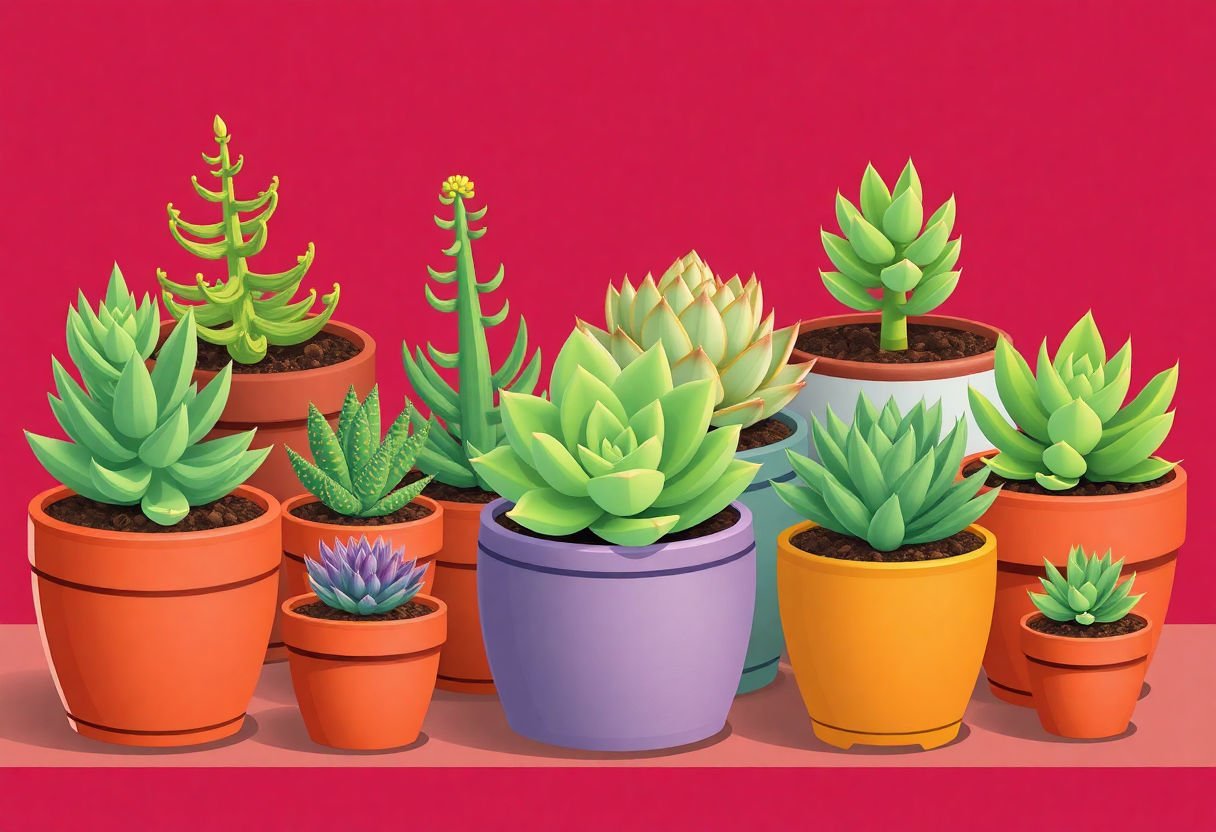Choosing the perfect pot for your succulent collection involves more than just aesthetic preferences. The pot you select will have a significant impact on both the health and appearance of your plants. This article delves into crucial aspects such as the significance of pot material, the necessity for adequate drainage, and the relationship between pot size and plant growth. Additionally, it highlights how pot design can seamlessly blend with your home decor while offering practical advice on potting techniques and maintenance. Embark on this journey to enhance both the beauty and vitality of your succulents.
Key Takeaways
- Pot choice significantly impacts both the aesthetic appeal and the health of your succulents; consider materials like ceramic, terracotta, and plastic for their unique benefits.
- Adequate drainage is crucial to prevent water retention that can harm succulents; choose pots with drainage holes or plan to drill them yourself.
- The size of the pot influences root growth and overall plant health; select a size that accommodates current and future growth without overcrowding.
- A pot’s design can enhance or clash with your home decor, so consider harmonizing colors and shapes with your interior style.
- Budget-friendly options include DIY pots or selecting price-conscious designers, ensuring you maintain style without compromising on quality.
Understanding Succulent Needs
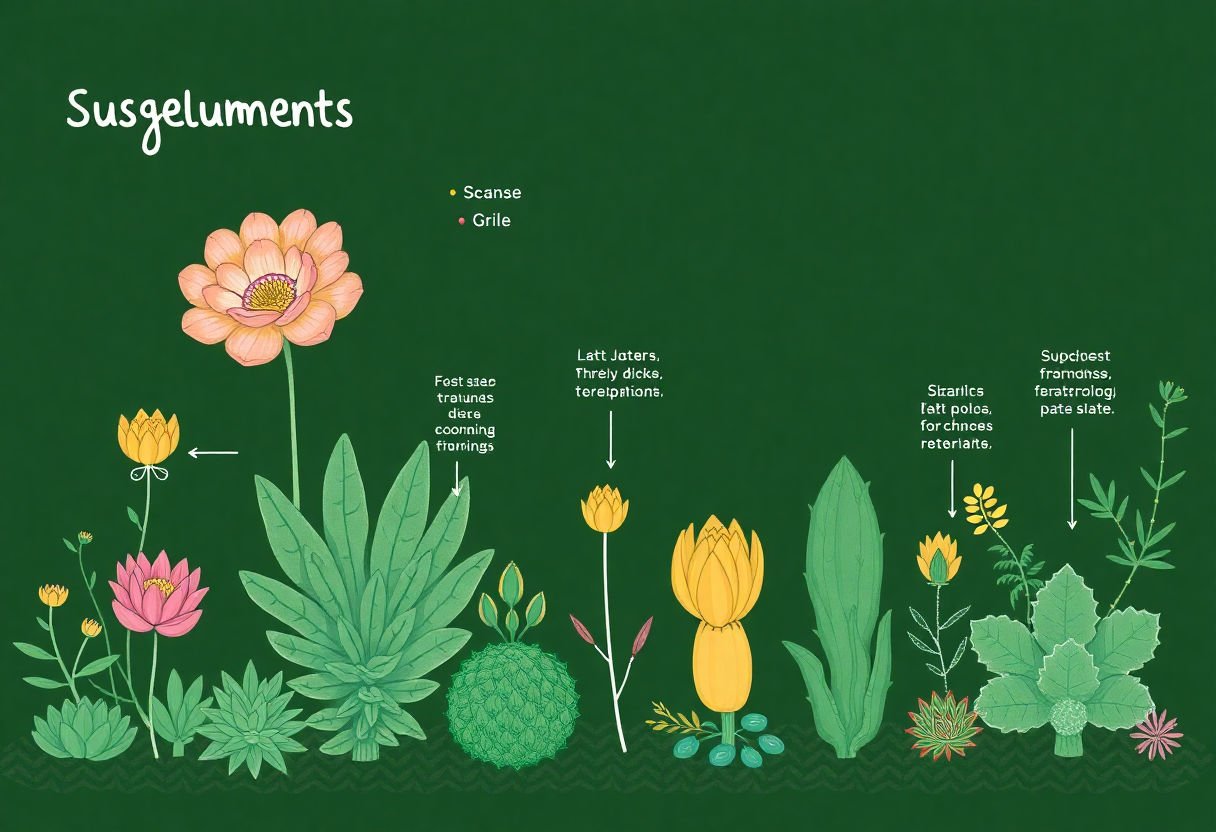
Succulents, with their striking forms and minimalist appeal, have gained immense popularity among plant enthusiasts. However, understanding the unique requirements of these plants is crucial for their thriving. Succulents are native to arid regions and have adapted to endure harsh conditions. This adaptation is characterized by thick, fleshy leaves designed to retain water, making them drought-tolerant. Consequently, your choice of pot must cater to these specific needs to encourage healthy growth.
Key Environmental Factors:
-
Light Requirement: Succulents bask best in bright, indirect sunlight. Depending on the specific variety, some may tolerate direct sunlight, while others may require more shaded conditions. Hence, it’s vital to position your pots in locations that fulfill these light preferences.
-
Temperature Tolerance: These plants prefer warmer climates and are sensitive to frost. Therefore, when selecting pots, consider the seasonal placement of your succulents to ensure they remain in optimal temperatures.
-
Water Retention and Soil Needs: Given their water retention capabilities, succulents require soil that dries out quickly. Choosing pots designed to promote rapid drainage is essential. Moreover, using a gritty, well-draining soil mix enhances their ability to thrive.
Understanding these environmental stipulations will guide you in choosing pots that support the natural growth patterns of succulents. This harmonizes not only their aesthetic presence but also their health, allowing your collection to flourish in its full glory. By accommodating their needs, succulent enthusiasts can ensure abundant growth and prolonged vitality in every chosen pot.
Material Matters
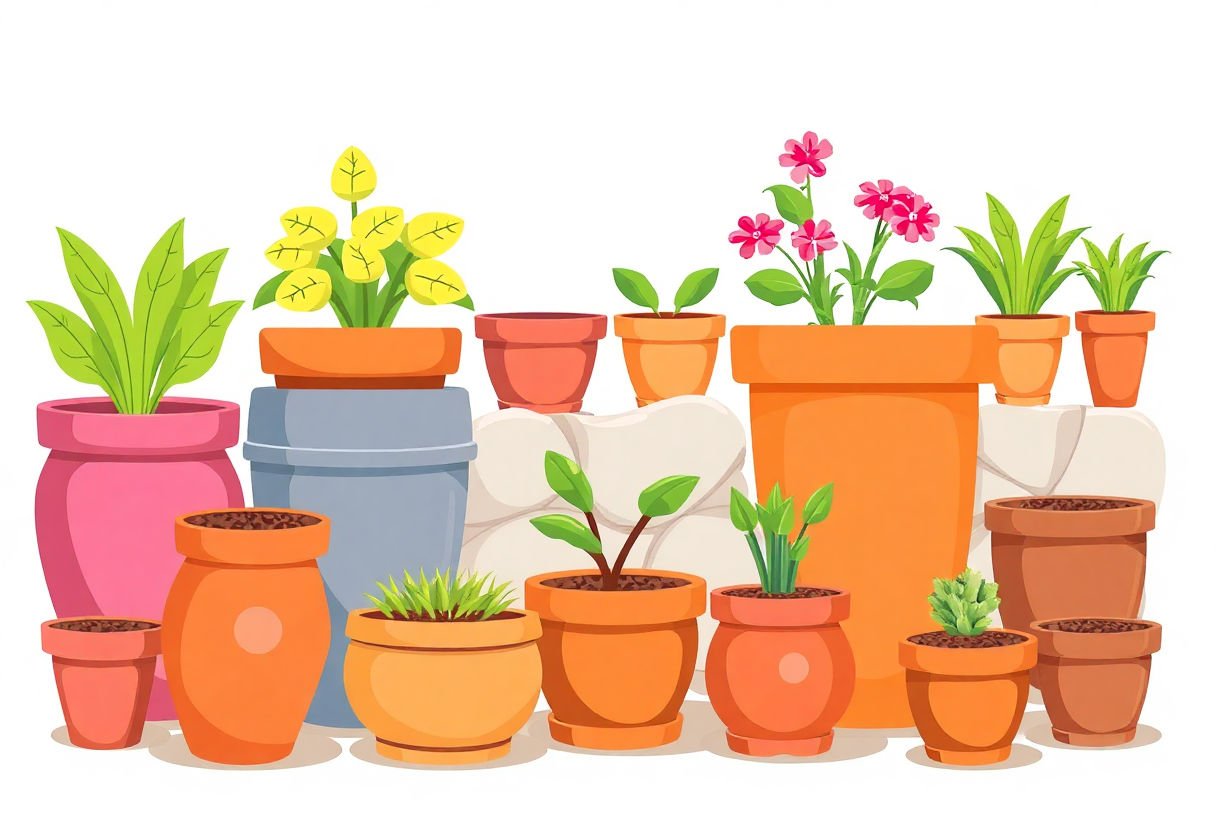
When selecting the perfect pot for your succulents, the material of the pot plays a pivotal role in both the aesthetic appeal and the health of the plant. Different materials offer distinct advantages and pose potential challenges that should be carefully weighed.
Ceramic pots are a popular choice due to their aesthetic flexibility. Glazed ceramic pots come in various colors and designs, making them an excellent choice for enhancing decor. However, they often lack sufficient drainage, which is crucial for succulent health. Opt for unglazed ceramics where possible, as they promote breathability and moisture regulation.
Terracotta pots are another favored option, renowned for their porous nature. These pots facilitate better air flow to the roots and quicker drying of soil, making them ideal for succulents which prefer less moisture. Their earthy appearance complements a more natural or rustic setting. Despite their benefits, they can be somewhat fragile, requiring careful handling.
Plastic pots are often chosen for their durability and affordability. They’re lightweight and usually come with sufficient drainage holes, making them easy to manage. Nonetheless, plastic can retain more moisture than desirable, which might lead to root rot if not monitored closely. They can also degrade over time when exposed to sunlight.
Metal pots provide a modern and sleek look, but they conduct heat, which can be harmful to plant roots. It’s best to reserve them for indoor use in controlled climates.
Ultimately, the choice of pot material should take into account not only aesthetic preferences but also the environmental needs of your succulents, ensuring their longevity and beauty.
Importance of Drainage
Drainage is paramount when it comes to ensuring the health and longevity of your succulent collection. These resilient plants, native to arid environments, thrive in conditions where water drains quickly, preventing root rot and other moisture-related issues.
When choosing a pot for your succulents, one of the most crucial features to look for is an adequate drainage hole at the bottom. This simple design element allows excess water to escape, helping maintain the optimal moisture level for your plants. Without proper drainage, even the most well-intentioned watering routine can lead to the accumulation of water at the base, suffocating roots and leading to decay.
For those pots that lack pre-drilled holes, consider drilling them yourself if the material permits. However, if modifying the pot is not an option, using a layer of gravel or small stones at the base can create a drainage layer that assists in preventing water stagnation, although this is not as effective as having a drainage hole.
To ensure your succulent’s success, pay attention to the soil mix as well. A pot with good drainage should be complemented by a specially formulated cactus or succulent mix, which typically contains a combination of soil, sand, and perlite or pumice. This mixture significantly boosts water drainage compared to regular potting soil.
Ultimately, understanding the critical role of drainage in succulent health not only preserves the beauty of your plants but also enhances their overall resilience and growth. This consideration should be at the forefront of your pot selection process.
Choosing the Right Size
Selecting the proper pot size for your succulents is crucial for their growth and root health. Succulents, known for their water-retaining abilities, have unique root systems that require careful consideration when choosing a pot. A pot that is too large can hold excess moisture, leading to root rot, while one that is too small may restrict root growth, stunting the plant’s development.
When deciding on the size of the pot, consider the following factors:
- Root Health: Succulents prefer pots where their roots can fit comfortably without excessive extra space. The ideal pot should be approximately 5-10% larger than the plant’s root ball, ensuring there is enough room for roots to grow without the danger of water pooling.
- Growth Potential: If you’re planning on your succulents growing, opt for a pot that allows for a slight increase in size. This will accommodate future root expansion without overwhelming the current root system.
- Re-potting Considerations: Regularly check your plants to determine when they need re-potting. Signs like roots protruding from the drainage holes or the plant appearing top-heavy indicate the necessity for a larger container.
Additionally, matching the pot size with the overall height and width of your succulents ensures a balanced appearance, providing a harmonious visual appeal to your collection. As you become more attuned to the needs of your succulents, selecting appropriately sized pots will become second nature, aiding in the overall health and beauty of your plants.
Aesthetic Considerations
When choosing a pot to enhance your succulent collection, the aesthetic appeal is a significant consideration that goes beyond simple functionality. The design of the pot can dramatically affect the overall visual appeal of your space, marrying the beauty of nature with artistic expression.
Firstly, consider the color palette of your room and choose pots that complement these hues. Neutral tones like black, white, and beige offer versatility and sophistication, allowing the vibrant colors of succulents to stand out. Alternatively, bold and vibrant pots can inject a playful element into your decor, catching the eye and adding personality to your interiors.
The shape and design of the pot also contribute to the aesthetic experience. Geometric designs can add a modern or contemporary vibe, while ornate patterns or rustic finishes may imbue a more traditional or eclectic style. Think of your pot as a functional piece of art; its texture and finish—whether matte, glossy, or textured—can evoke different moods and styles, catering to your personal taste and existing decor.
Moreover, the size and arrangement of pots can create intriguing visual dynamics. A cohesive collection of pots with varying heights and shapes can establish a visually appealing structure, enhancing the display of your succulents. Using pots of different sizes allows for creative grouping or spacing, both of which affect the perception of depth and focus within a room.
Ultimately, your choice of succulent pot can be a reflection of your personal style and creativity, as well as a thoughtful contribution to your overall home aesthetics.
Potting Techniques
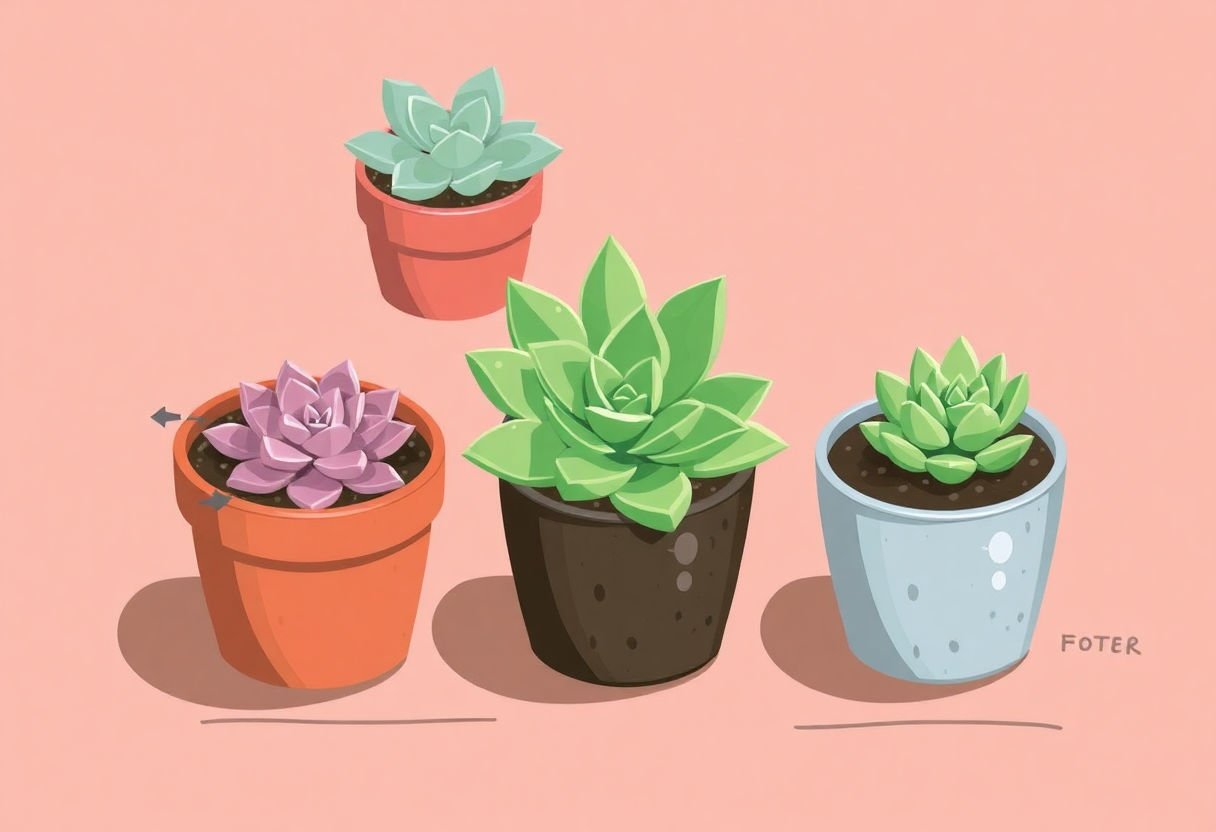
To ensure your succulent plants not only survive but thrive, employing proper potting techniques is indispensable. Begin by selecting an appropriate pot that aligns with the specific needs of your succulent. The material and design of the pot should support the plant’s growth requirements, ensuring that the roots can breathe and avoid excessive moisture.
Before potting, line the bottom of your pot with a porous material. This assists in drainage and prevents soil compaction. A layer of gravel or small stones can provide an effective drainage base. Following this, fill your pot with a well-draining soil mix, such as cactus or succulent potting soil, which enables water to flow adequately and air to circulate around the roots.
When planting your succulents, position them so that the root ball is entirely covered by soil, leaving a slight gap at the top of the pot for watering purposes. Gently pack the soil around the roots to remove any air pockets, which can cause roots to dry out and impede their ability to absorb nutrients.
An often underappreciated aspect of potting succulents is providing them with the right post-potting care. After planting, refrain from watering your succulents immediately. This pause allows any damaged roots to heal and helps prevent root rot. Typically, a waiting period of one week is recommended before resuming regular watering.
Finally, remember to regularly rotate your potted succulents. This ensures even exposure to sunlight, fostering symmetrical growth and avoiding the unsightly lean that can occur when the plant stretches toward light sources. By adhering to these best practices, your succulents will be set on a path to grow healthily and beautifully.
Maintaining Your Potted Succulents
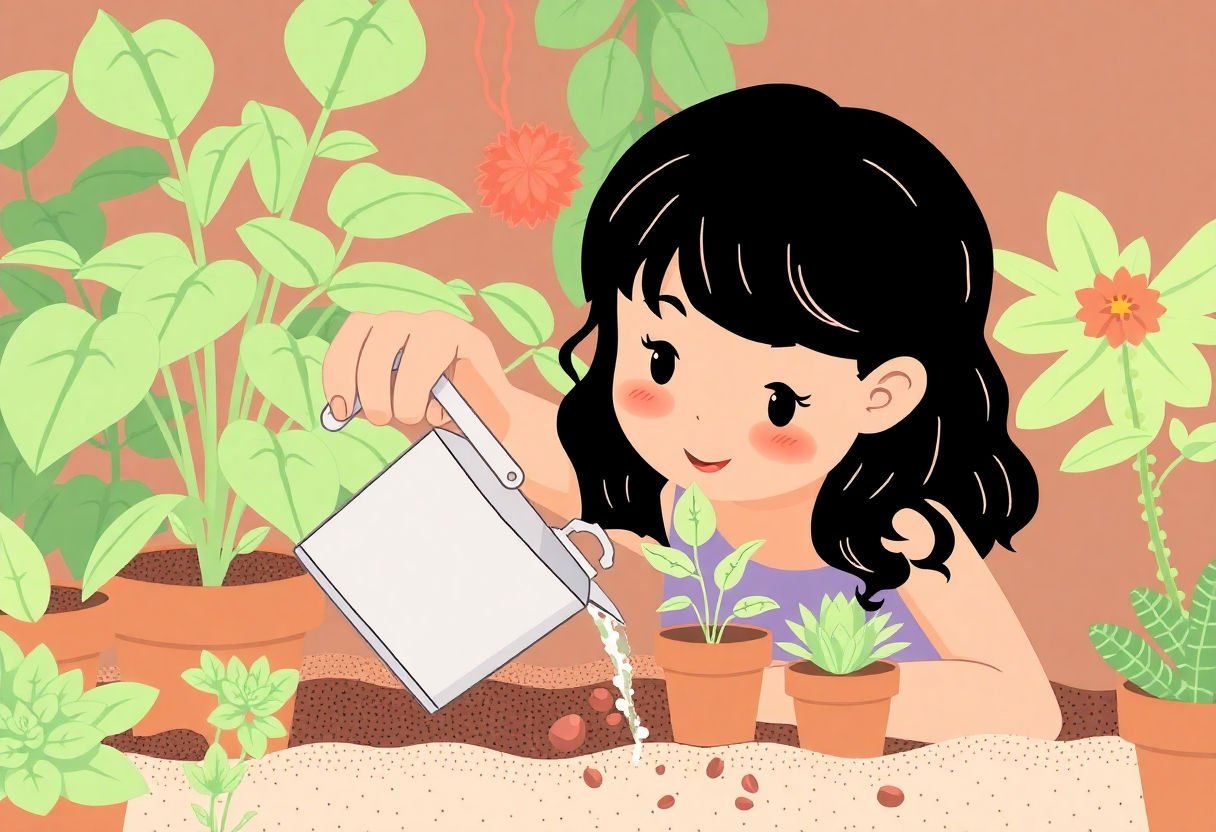
Proper indoor succulent care is essential for their longevity and vibrancy. Watering is a critical aspect that must be appropriately managed. Succulents typically require less frequent watering than other plants due to their ability to store water in their leaves. It is advisable to water your succulents every two weeks, allowing the soil to dry out completely between sessions. Overwatering is a common mistake that can lead to root rot. One handy tip is to ensure that when watering, it is done thoroughly, allowing water to drain out of the bottom of the pot.
Regarding sunlight, succulents thrive in bright, indirect light. Placing them near a window that receives abundant natural light will usually suffice. However, be cautious of prolonged direct sunlight, as it could scorch the leaves. Rotate your pots periodically to ensure even light distribution and encourage balanced growth.
Basic care extends beyond watering and sunlight. Dust accumulation on leaves can impede photosynthesis; thus, it is beneficial to gently clean leaves with a damp cloth occasionally. Nutrient supply can also play a role in maintaining succulent health. During the growing season, from spring to early autumn, consider a diluted fertilizer designed for succulents once a month.
By following these practices, your potted succulents can flourish, adding tranquility and beauty to your surroundings. These small but effective measures ensure your succulents remain resilient and robust throughout their lifecycle.
Seasonal Adjustments
As the seasons change, so do the needs of your succulent collection, making it imperative to adjust both care routines and pot locations. Winter months, characterized by diminished sunlight and cooler temperatures, suggest relocating succulents to south-facing windows or installing grow lights to maintain adequate light exposure. It is crucial to reduce watering frequency during this period to prevent overwatering, as succulents enter a dormant phase and require less moisture.
Conversely, summer brings increased sunlight and warmth, which may necessitate moving your succulents away from direct, harsh sunlight to prevent sunburn. Ensure the pots have ample airflow around them, promoting evaporation and preventing heat stress. During this season, succulents typically require more frequent watering, yet it’s important to monitor soil dryness and adjust watering schedules accordingly.
In spring and fall, transitional care is key. Spring is an ideal time to repot, if necessary, providing fresh soil and larger pots for growing succulents. During fall, start preparing for winter by gradually reducing watering and considering the use of heat mats to counteract cold drafts.
Adjusting your succulents’ potting environment and care routines according to seasonal changes ensures they not only survive but thrive throughout the year, preserving both their health and aesthetic appeal. These careful adjustments act as the foundational cornerstone of successful succulent care, maintaining their vivid beauty and robustness across diverse seasonal challenges.
Cost-Effective Potting Options
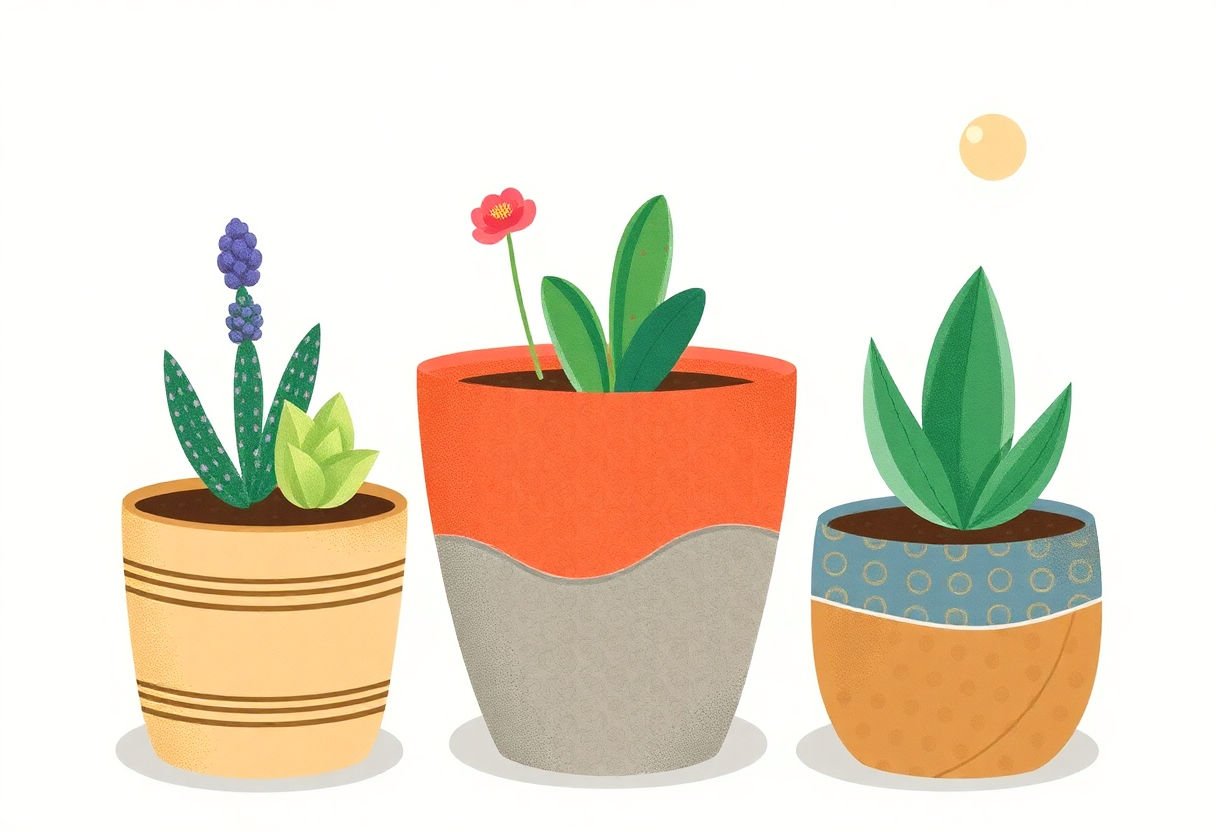
To maximize the aesthetic appeal of your succulent collection without breaking the bank, consider several cost-effective potting strategies that combine creativity with practicality.
Budget-Friendly Designers: Many pot designers offer reasonably priced collections that maintain both style and function. Look for sales or discounts from popular retailers during major shopping events. Consider brands that focus on environmentally-friendly practices, which often provide stylish yet sustainable options.
DIY Solutions: Embrace the art of DIY to craft unique pots. Upcycling household items such as old bowls, tea tins, or mason jars can serve as distinctive planters. Simply drill small drainage holes at the bottom if necessary. This not only reduces costs but adds a personal touch to your decor.
Thrift and Vintage Stores: Scour local thrift stores and flea markets where you might find charming, vintage pots at a fraction of retail prices. These places often carry hidden gems that add a unique flair to your plant displays.
Community Pot Swaps: Engage with local gardening communities or social media groups to organize or participate in pot swaps. This exchange allows you to refresh your collection by trading pots you no longer need for new-to-you options.
Cooperative Purchases: Pool resources with fellow succulent enthusiasts to purchase bulk pots at wholesale prices. This cooperative approach can significantly reduce the cost per pot, making high-quality options more accessible.
Each of these strategies not only aids in maintaining a cost-conscious gardening practice but also promotes sustainability and creativity, principles that benefit both the gardener and the environment.
Conclusion
Selecting the ideal pot for your succulents is a crucial decision that affects both their aesthetic appeal and health. By understanding the specific needs of succulents, such as proper drainage and optimal pot size, you ensure they thrive in any environment. Consider the material that best suits your décor and climate, and remember that even with a modest budget, cost-effective solutions abound. As you build your collection, maintain a balance between functionality and style, knowing that well-chosen pots not only enhance the beauty of your plants but also contribute to a greener, more vibrant living space.
Frequently Asked Questions
How important is drainage in the pots used for succulents?
Proper drainage is crucial for succulents, as excess water can lead to root rot, which is detrimental to their health. Pots with adequate drainage holes allow water to escape easily, maintaining an optimal moisture balance in the soil.
What materials are best suited for succulent pots?
The choice of material depends on both aesthetic preference and practical considerations. Terracotta and ceramic are excellent for providing breathability and stability, while plastic pots are lighter and often more affordable. Consider how each material affects water retention and weight.
How do I choose the right size pot for my succulent?
Select a pot that is slightly larger than your succulent’s root ball to allow for growth while avoiding excess soil that retains moisture. This ensures your succulent has space to grow without risking waterlogged soil.
Can the design of a pot affect my succulent’s health?
While pot design is primarily an aesthetic choice, certain designs may hinder drainage if not properly equipped with drainage holes. Opt for pots that enhance both visual appeal and the functional needs of the plant.
Are there budget-friendly options for purchasing or making succulent pots?
Yes, there are several cost-effective avenues, including thrift store finds and DIY projects. Reusing household items, like porcelain bowls with drilled holes, can provide unique and personalized pots at minimal cost.
